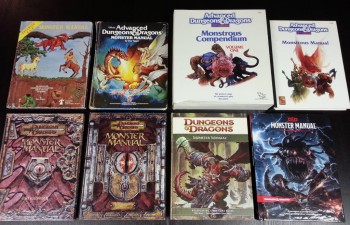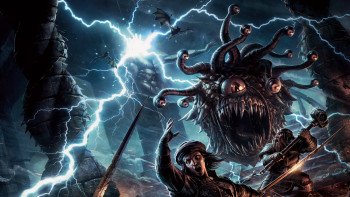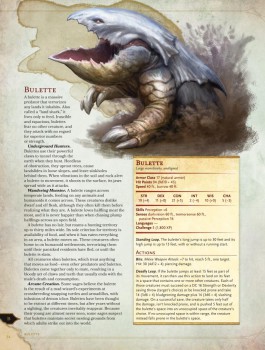Art of the Genre: A Review of the 5E Monster Manual and its Place in D&D Product History

So a month ago, I had the pleasure of reviewing the new Dungeons & Dragons 5th Edition Players Handbook. At first, it seemed to me that I’d be doing a rather standard review, but the more I read the product, the more it began to light a fire in me about what the game had to offer.
New mechanics, or should I say neo-retro, because it seamlessly combines great features of both old and new D&D, had me wondering just how the game played on a table-top. By the end, I fully understood that this was not only a product to be respected, but also that I had to take the first chance I got to play it.
That said, I began to break down the mechanics and tried to extrapolate them into a small adventure that would help new players better understand the flow of the game. It was a truly fun and insightful process, but the double-edged sword of it was that I needed monsters!
Now sure, as an experienced DM with 30+ years behind the screen, I was able to extrapolate statistics from older versions of the game and translate them to 5th Edition, and it also helped to have a copy of the 5E Starter Kit, but if you’ve ever run a game of D&D, you know that it is always nice to have a copy of the Monster Manual close by! So, it is with great pleasure that I get to introduce players and fans alike to just what has changed in the 5E version of the game where monsters are concerned.

The book itself, a nice-sized tome of 350 pages, is full color with a cover by Richard Swanland. The art itself took an astounding six art directors to organize the nearly fifty interior artists involved. Now I understand that might break the cohesion of the book, as most MMs of the past have featured just two or three interior artists, but I think WotC has done a commendable job keeping the overall flow in the right place.
One of the first things to note as you begin reading the book is that gone are the weighty procedural aspects of some things players had seen from 3rd Edition on, as well as in Pathfinder. The monsters, much like the game itself, have been streamlined. Yes, there are still classifications, referred to here as ‘types’ (Fey, Aberration, Oozes, etc), but those are pulled back beneath the byline. Ability scores are pushed forward into a kind of break-line that helps divide a handful of statistics needed to quickly reference and run each monster.
I think this speed of use is the most important aspect of the design. Above each monster’s ‘break-line’, you get three items of importance: Armor Class, Hit Points (with the new mechanic of average as a flash grab), and Speed. Now personally, not being a miniature gamer, speed statistics are a fairly useless ‘upper ability’ stat to me, but still, I can roll with three total hard stats above the break.

Below the break, you are going to get the monster’s special condition stats, usually no more than five, such as Damage Immunities, Senses (Blindsight, the passive Perception stat, and the like), Skills, Saving Throws, and of course Challenge Rating (for exp value and to see if the monster should kill your characters or not). I will also note that there is a clean experience chart for challenge rating added in the front for easy reference.
Beneath this stat block, you will get the special ability descriptions for each monster that take a few lines each to explain anything the monster can do that make it unique and memorable, and finally another section marked Actions, that provide combat maneuvers the monster can use (Multiattack, Slam, etc).
Most monsters in the book take less than a page to be brought to life, with some larger monster classes like Dragons or Beholders getting a much more detailed two-page write-up before heading into the meat of the monster stats.
It must also be noted that as D&D owns the rights to some classic monsters unique to their system, this will be the one place you can find those, so keep that in mind. (And I challenge gamers out there to tell me what they are and reply below!) The only other observation I’ve noted is a bit of alignment creep on certain monsters that might throw some players and spell-casters who lean heavily on that mechanic, but as I’ve never been overly involved in alignment; it doesn’t really bother me.
In all, this is a very sharp book in the gaming ‘Big Three’ (Players Handbook, DMG, and MM), and anyone looking to take on the challenge of 5E will be happy with what they’ve invested in. The 5E Monster Manual is now available and retails at $49.99.
Also, for those who are looking to dip their toe into 5E, I’ve got the perfect small 5E neo-retro module for you in my new Kickstarter campaign. It combines old school TSR ‘quick’ modules, Dragon Magazine painted covers, and high tech dungeons and graphics to round out the 5E feel. Hopefully you’ll help support the cause at AotG; we sure could use you!
If you like what you read in Art of the Genre, you can listen to me talk about publishing, and my current venture with great artists of the fantasy field, or even come say hello on Facebook here. And my current RPG Art Blog can be found here. Also, take a look at the new AotG, RPG module Kickstarter below!
To my mind, the most significant D&D-only monster is the good old Mind Flayer (bringing a welcome touch of Cthulhoid horror to your games since the 1970s). I suppose that would also spread to encompass Githyanki and Githzerai.
(and that makes me sad (but should make the rest of the world happy) because it means I won’t be able to write my Wheel of Time-sized epic tale of the Gith rebellion against the Illithid empire.)
I’ve had two brilliant sessions with 5e and am eagerly looking forward to my third. Even ordinary low-level common creatures, like hyenas and baboons, can become really nasty in large numbers. A mob of Orcs or well-designed team of Drow would be terrifying. An imaginatively-played Beholder, Mind Flayer, or Dragon is an extremely tough opponent. This is a book to be studied and respected.
Joe: You are correct sir, yes! 🙂 Hey, I’m waiting on a Joe to show up on my KS backer report because I know you are one of my people, where are you? 😉
EE: WHY AREN’T WE GAMING TOGETHER! 🙂 Now I want you running my Folio module so I can hear the stories of just how you applied your above thoughts!
Joe: There you go, and YES, I WANT A GITH UPRISING NOVEL!!!!!!!!!!!!!!!!!! 🙂
Seriously: Of all the things TSR ever created in off-hand flavor text references in modules and monster descriptions, that’s the one that’s most caught my imagination over the years. Now I have to go dig out the Dragon issue with Ecology of the Mind Flayer in it …
Joe H: That would be Dragon #78 if you are wondering 🙂 Article is by Roger Moore.
And conveniently, I have my Dragon Magazine Archive already installed right here on my PC … 🙂
Scott, my campaign is on roll20, it’s still getting going.
EE: You aren’t the first person to talk to me about roll20 today. Now I just need one more and the rule of three will be fully in play! 🙂
Joe H, if you find the ecology of the mind flayer article, shoot me some bullet points. I plan on using one as a major behind-the-scenes villain.
Scott, I was looking at the sample maps for your kickstarter and thinking how easy they’d be to adapt to roll20. 🙂
EE: Well, if it is a possibility, let me know, I’ll be happy to do what I can to make them available if you don’t have to be a technical genius [which I’m not] 🙂
Scott, if you want to send me one (the old school grid one might be best) in some kind of common graphic format I could toss it into roll20, add some adventurers, monsters, and objects, then screenshot it for you to show others how easy it is.
EE: I’ll see what I can do 🙂